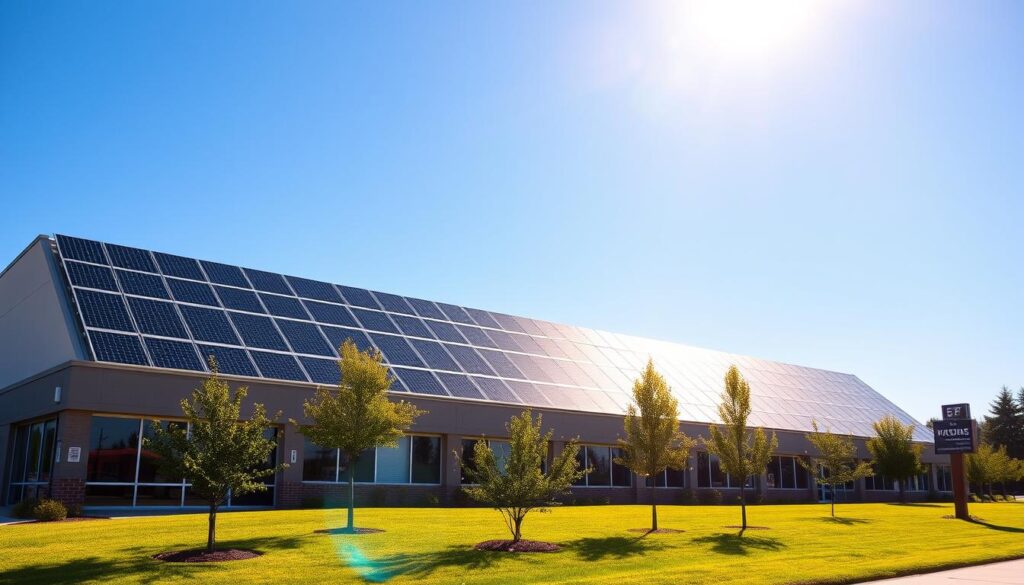Pennsylvania Commercial Solar: A Guide to Rooftop Power
What if you could dramatically slash your energy bills while simultaneously making a powerful statement about your company’s values?
For more information – Click Here
Harnessing the power of the sun is no longer just a trend—it’s a smart business decision. For companies looking to reduce operating costs and embrace sustainability, solar energy offers a transformative solution. By converting idle rooftop space into a renewable energy resource, businesses can achieve significant savings while demonstrating their commitment to environmental responsibility.
With rising energy costs, adopting solar panel systems provides long-term financial stability. These systems not only lower monthly utility bills but also offer operational flexibility. Additionally, federal tax credits and incentives make the transition to renewable energy more accessible than ever.
For businesses in Pennsylvania, integrating solar power is a strategic move. It aligns with corporate social responsibility goals while ensuring a reliable energy source. Whether you’re a small business or a large enterprise, the benefits of solar energy are clear. Ready to explore how your company can thrive with solar? Let’s dive into the details.
Understanding Solar Energy Benefits for Your Business
Adopting renewable energy solutions can significantly enhance your business operations. By integrating clean energy systems, you can reduce operational costs and stabilize annual electricity expenses. This transformation turns traditional cost centers into revenue-saving assets, ensuring long-term financial stability.

One of the most compelling advantages is the availability of federal tax credits. These incentives can offset a significant portion of your initial investment, making the transition more affordable. Over the years, these savings compound, providing a strong return on investment.
Beyond financial benefits, renewable energy aligns with corporate social responsibility goals. It enhances your company’s image, showcasing a commitment to sustainability. This can attract eco-conscious customers and partners, further boosting your brand’s reputation.
Additionally, the stability of energy costs allows for better fiscal planning. By generating your own power, you’re less vulnerable to fluctuating utility rates. This predictability can lead to improved cost management and higher profitability over time.
In summary, investing in clean energy is a strategic move that offers both economic and environmental rewards. It’s a step toward a more sustainable and financially secure future for your business.
Evaluating Financial Incentives and Tax Benefits
Exploring tax benefits and credits can significantly reduce your upfront costs. One of the most impactful incentives is the Solar Tax Credit, which covers up to 30% of your project expenses. This federal program makes renewable energy investments more accessible and affordable for businesses.
Another key benefit is the Modified Accelerated Cost-Recovery System (MACRS). This allows you to recover the value of your investment through depreciation deductions over five years. It’s a powerful tool to enhance your financial returns.
Additionally, Solar Renewable Energy Credits (SRECs) can turn your energy production into extra revenue. For every megawatt-hour of power generated, you earn credits that can be sold on the market. This creates a steady stream of savings over time.
Combining these incentives can lead to substantial cumulative benefits. For example, a typical project could see a payback period of just 8.5 years. This makes renewable energy a smart long-term investment for your business.
Understanding these financial mechanisms is crucial. They not only lower your initial costs but also provide ongoing value. By leveraging these opportunities, you can maximize your savings and achieve a stronger return on investment.
Solar Panels On Commercial Buildings in Pennsylvania
Transforming your business with clean energy is a forward-thinking strategy. By integrating a solar system, you can maximize the use of your property while reducing energy expenses. This approach not only lowers costs but also enhances your company’s renewable energy profile.
A well-designed system ensures optimal financial and energy performance. It leverages federal, state, and local incentives to make the project more affordable. Over time, these savings compound, providing a strong return on investment.
Converting existing roof space into a productive energy source is a smart move. It allows you to generate power while maintaining operational efficiency. Businesses in Pennsylvania have reported significant savings and improved financial stability after adopting such solutions.
The integration process is seamless when planned correctly. From design to execution, every step is tailored to ensure maximum benefits. This includes evaluating energy needs, selecting the right equipment, and optimizing installation for long-term performance.
By investing in a robust commercial solar solution, you’re not just saving money—you’re building a sustainable future. It’s a strategic decision that aligns with your financial goals and environmental commitments.
Maximizing Rooftop and Ground-Mounted Solar Solutions
Both rooftop and ground-mounted solutions offer unique advantages for maximizing energy output. Choosing the right approach depends on your property layout and energy goals. Each method has its strengths, and understanding them can help you make an informed decision.
Rooftop systems are ideal for businesses with limited ground space. They utilize existing structures, making them a practical choice for urban areas. Proper installation ensures maximum exposure to sunlight, boosting electricity generation.
Ground-mounted systems, on the other hand, provide greater design flexibility. They can be positioned for optimal sun exposure, often yielding higher energy output. This option is perfect for properties with ample land and minimal shading concerns.
Strategic planning is key to maximizing your investment. Assess your property to determine the best setup. Consider factors like available space, sun exposure, and long-term energy needs. This ensures your system operates at peak efficiency.
Incentives play a crucial role in making these solutions more accessible. Federal and state programs offer incentives that reduce upfront costs. These programs make it easier to adopt energy systems that align with your business goals.
By optimizing your installation, you can achieve significant long-term benefits. Whether you choose rooftop or ground-mounted systems, the right approach enhances energy production and operational value. It’s a smart way to future-proof your business.
Leveraging Net Metering for Sustainable Savings
Net metering is a game-changer for businesses aiming to cut energy costs sustainably. This system allows your company to feed excess electricity back into the grid, earning credits that offset future bills. It’s a smart way to maximize your investment in solar power while reducing reliance on traditional energy sources.
The process begins with installing digital bi-directional meters. These devices track both energy production and consumption, ensuring accurate credit calculations. Your company can monitor energy usage in real-time, making it easier to optimize efficiency and savings.
Many state policies support net metering, providing stability in managing energy costs. For example, Pennsylvania’s program allows businesses to carry over unused credits month-to-month. This ensures you benefit from every kilowatt-hour generated, even during off-peak periods.
By leveraging net metering, your company can achieve significant long-term savings. It reduces overall energy expenses and enhances operational efficiency. Plus, it aligns with sustainability goals, showcasing your commitment to clean energy solutions.
Real-life examples highlight the success of this system. Businesses in Pennsylvania have reported substantial savings and improved financial stability. Net metering not only lowers bills but also provides a reliable way to manage energy cost spikes.
In summary, net metering is a powerful tool for sustainable savings. It transforms excess energy into financial benefits, helping your company thrive while supporting a greener future.
Exploring Alternative Structures: Solar Canopies and More
Innovative solar structures like canopies and carports are transforming how businesses harness renewable energy. These solutions expand beyond traditional roof-mounted systems, offering versatility and additional utility. They’re ideal for properties with limited space or unique design needs.
One of the most popular options is the solar canopy, often installed in parking lots. These structures not only generate clean energy but also provide shade and protection for vehicles. This dual functionality enhances the value of your building while supporting sustainability goals.
Integrating these structures into existing spaces is straightforward. They can be customized to match your property’s layout and energy requirements. For example, a well-designed canopy can maximize sunlight exposure, ensuring optimal energy production at a competitive rate.
Design considerations include structural integrity, sun exposure, and aesthetic appeal. Proper planning ensures these systems complement your property’s architecture while delivering maximum benefits. Additionally, they can be paired with net metering programs to further reduce energy costs.
These alternative solutions work seamlessly with traditional roof-mounted systems. Together, they create a comprehensive energy strategy that maximizes output and operational flexibility. This approach is particularly effective for businesses looking to future-proof their energy needs.
By investing in innovative solar projects, you’re not just generating clean energy—you’re enhancing your property’s functionality and value. It’s a smart way to align your business with sustainability while achieving long-term financial benefits.
Navigating Commercial Solar Policies in Pennsylvania
Understanding state policies is crucial for successful energy projects. Pennsylvania offers a robust framework to support businesses in adopting clean energy solutions. By aligning with these guidelines, you can ensure your project meets regulatory standards while maximizing benefits.
One key policy is the Solar Renewable Energy Credit (SREC) program. This initiative allows businesses to earn credits for every megawatt-hour of energy produced. These credits can be sold, creating an additional revenue stream. It’s a smart way to offset initial costs and enhance long-term returns.
Another critical aspect is net metering. This policy lets you feed excess energy back into the grid, earning credits that reduce future bills. Utility companies integrate this into their billing process, making it seamless for businesses to manage energy costs. Pennsylvania’s net metering program ensures you benefit from every kilowatt-hour generated.
State and local regulations also play a vital role. These guidelines ensure your system is installed safely and efficiently. Compliance with these rules is essential for smooth project execution. Working with experienced professionals can help you navigate this process effectively.
Incentives like the Alternative Energy Portfolio Standard (AEPS) further support your efforts. This program sets renewable energy goals, encouraging businesses to contribute to a cleaner grid. By participating, you can access additional financial benefits and enhance your company’s sustainability profile.
To optimize your system’s performance, it’s important to understand these policies thoroughly. They not only reduce costs but also ensure your project aligns with state objectives. By leveraging these opportunities, you can achieve a stronger return on investment and contribute to a greener future.
Implementing Your Commercial Solar Project: A Step-by-Step Guide
Starting your journey toward clean energy begins with a well-structured plan. A successful project requires careful planning, from initial assessments to system activation. Here’s a detailed guide to help you navigate the process seamlessly.
First, conduct a thorough site evaluation. Assess your property’s energy needs, roof condition, and sun exposure. This step ensures your solution is tailored to maximize efficiency. Professional engineers can provide detailed insights, helping you avoid costly mistakes.
Next, explore financing options. Programs like C-PACE offer flexible terms, making it easier to fund your project. Federal tax credits and state incentives can significantly reduce upfront costs. Understanding these opportunities ensures your investment is both affordable and profitable.
Once financing is secured, move to the design phase. Engineers will create a system that aligns with your energy goals and property layout. This stage includes detailed calculations and compliance with local policy requirements. A well-designed system ensures optimal performance and long-term savings.
The installation process follows, with contractors handling everything from equipment setup to grid connection. Regular communication ensures the project stays on track. After activation, ongoing maintenance is crucial. Monitoring performance helps identify issues early, ensuring your system operates at peak efficiency.
By following this step-by-step guide, you can reduce risks and maximize the benefits of your clean energy investment. A well-planned project not only lowers costs but also supports sustainability goals. Ready to take the first step? Start your journey today.
Conclusion
Switching to sustainable energy offers both financial and environmental rewards. By adopting renewable systems, you can reduce operational costs and enhance your facility’s efficiency. This approach maximizes your available space, whether through rooftop or ground-mounted solutions, tailored to your property’s size and layout.
Financial incentives like tax credits and net metering make this transition more accessible. These programs not only lower upfront costs but also provide long-term savings. Additionally, innovative structures like canopies expand your options, ensuring optimal energy production while adding value to your facility.
Understanding state policies and installation strategies is key to success. By following a step-by-step guide, you can ensure a seamless process. Lumina Solar PA is here to help you explore your options and implement a solution that aligns with your goals.
Ready to transform your facility with clean energy? Take the first step today and unlock the benefits of a sustainable future.




